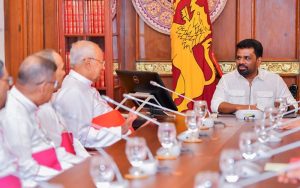Targeting Rs 80B T-Bill auction: CBSL advances NEL to Rs 191.21B

Central Bank of Sri Lanka (CBSL), targeting Wednesday’s (9) Rs 80,000 million (Rs 80 billion) Treasury (T) Bill auction, sharply enhanced net excess liquidity (NEL) for the third consecutive market day to Friday (4), this time via foreign exchange (FX) purchase settlements from banks.
Consequently NEL, Friday over the previous market day Thursday (3) increased by 4.10 per cent (Rs 7,530 million) to
Rs 191,213 million (Rs 191.21 billion). The value of Friday’s FX settlements was USD 24.86 million (Rs 7,360 million). Conversions are based on the offer value of the benchmark ‘spot’ as at Wednesday (2) which was Rs 296.07 to the US dollar.
When CBSL buys FX from the market to strengthen the country’s foreign reserves as per IMF diktats, an equivalent amount of rupees is also released to the money market, thereby enhancing NEL. Meanwhile, CBSL added on a further Rs 170 million to NEL by way of increasing Government of Sri Lanka’s (GoSL’s) demand-pull inflationary face value money printing (FVMP) debt, thereby upping GoSL’s FVMP debt as a whole by 0.01 per cent to Rs 2,512,090.63 million on Friday.
However, year-on-year (YoY) to Friday, GoSL’s FVMP debt has fallen steeply by Rs 299,845 million (10.66 per cent), thereby sharply negating demand-pull inflationary pressure. A year ago, GoSL’s FVMP debt was recorded as being at Rs 2,811,935.63 million, data showed.
Such steep YoY falls in GoSL’s FVMP debt, as happened on Friday (4), are possible because of record-high taxes and utility rates charged on the public due to IMF diktats. The latest of such hikes has been VAT being upped from 15 to 18 per cent since the beginning of last year. The value of GoSL’s FVMP debt is equivalent to the FV of CBSL’s T-Bill and T-Bond holdings at the end of Friday’s trading, vis-à-vis such purchases made by CBSL from both the primary and secondary markets.
Banks and/or their customers like GoSL and/or its agents suffering from rupee illiquidity have to surrender, in such instances only banks, their T-Bill/T-Bond holdings to CBSL, which in turn prints money and lends to those banks, values equivalent to the face value of those surrendered T-Bond/T-Bill holdings, thus meeting their (GoSL’s and/or its agents and banks) liquidity needs.
GoSL’s and/or its agents’ foreign debt servicing commitments are met by the country’s foreign reserves and not by banks, for fear if met by the latter, that would cause depreciative pressure on the rupee, as Sri Lanka is an import-dependent economy. When such FX payments are made, an equivalent amount of rupee liquidity is withdrawn from the market and credited to the CBSL account in lieu.
CBSL, the steward of GoSL debt and also of its foreign reserves, in its FX transactions, deals in ‘spot’. ‘Spot’ trades are settled after two market days from the date of trading. CBSL buys FX from banks to strengthen the country’s foreign reserves, a requirement of the IMF. This action results in the release of an equivalent value of rupees to the money market.
Selling T-Bills and T-Bonds to the market is a mechanism adopted by the GoSL to raise money locally to meet its internal financial needs. Investments in T-Bonds and T-Bills are usually risk-free, because in the event GoSL is unable to honour such commitments, CBSL generally prints demand-pull inflationary money and repays such creditors. Money printing is the sole prerogative of the CBSL. Inflationary money is also known as GoSL’s demand-pull inflationary FVMP debt.










